Copilot Coming to Microsoft 365

By now you’ve seen the previews of Microsoft’s unique capabilities using large language models within Microsoft 365 Apps like PowerPoint and Excel. Known as Copilot, it’s generating a lot of buzz amongst fans and critics. This blog summarizes some of the more subtle advantages of the technology, timelines of when you might see the capabilities, how it works, and how you can thoughtfully prepare to take prudent advantage of it.
When Can You Try It?
Unless you were fortunate to be one of the handful of private preview invitees, you’ll have to wait several months for this technology to be in your tenant. Typical Microsoft timelines vary but three to six months would be a minimum for this to start to go into broader private preview, followed by public preview, where the masses will start to see it. Make sure your tenant admins are part of the Office Insider program. There are also admin capabilities that control preview features for users. For instance, in Teams, it’s now more foolproof to enable users for Microsoft Teams Public Preview before new versions roll out to the rest of the company. There, Microsoft is adding a new value named ‘Forced’ for this to move users to Public Preview without them having users opt-in.
Licensing and pricing are not being disclosed at this time, but from experience, anytime Microsoft augments existing tooling with AI/automation, it will require an incremental investment.
At this time, there is no plan of record for Copilot within education or government tenants.
Unique Capabilities Draw from Multiple Apps
It would be simple enough to say Copilot will bring ChatGPT type capabilities to Office, reducing writer’s block by allowing users to ask to “Draft a proposal” or “Start a presentation” about certain topics. However, its real strength appears to be in connecting and extracting data from existing apps and data within M365.
For instance, Copilot can connect to customer notes from OneNote and other internal documents, drawing data out of these documents to create a first draft. See how the “create based on” calls upon a customer OneNote. This is a major time saver to create a draft without copying/pasting.

Then, to quickly ensure consistency, you can ask Copilot to reformat the draft into a document template that you’ve used in prior documents.
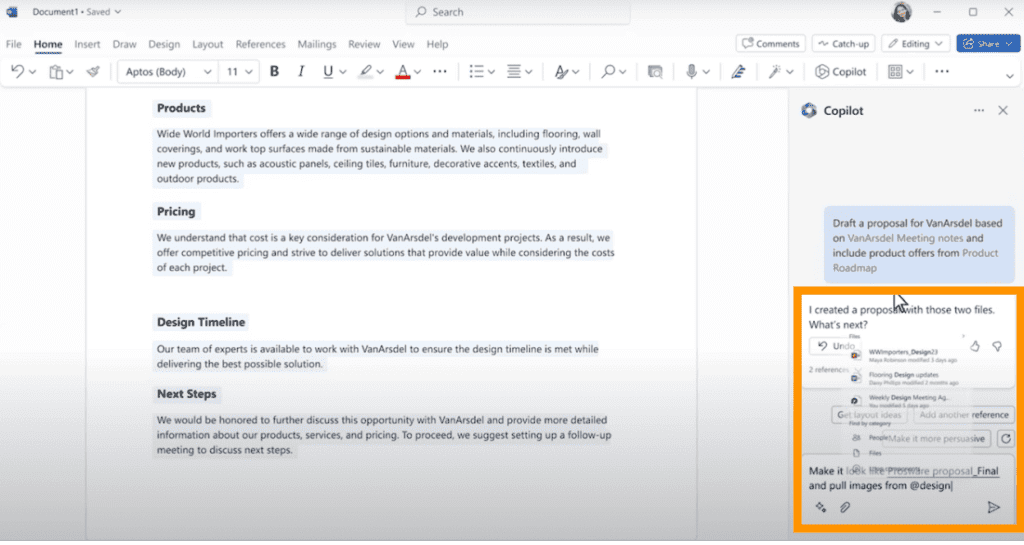
The time savings of both steps are immense productivity enhancements.
As another example, a PowerPoint presentation can be drafted from a Word document! Writing once, reusing everywhere without copying/pasting will be a major productivity boost.
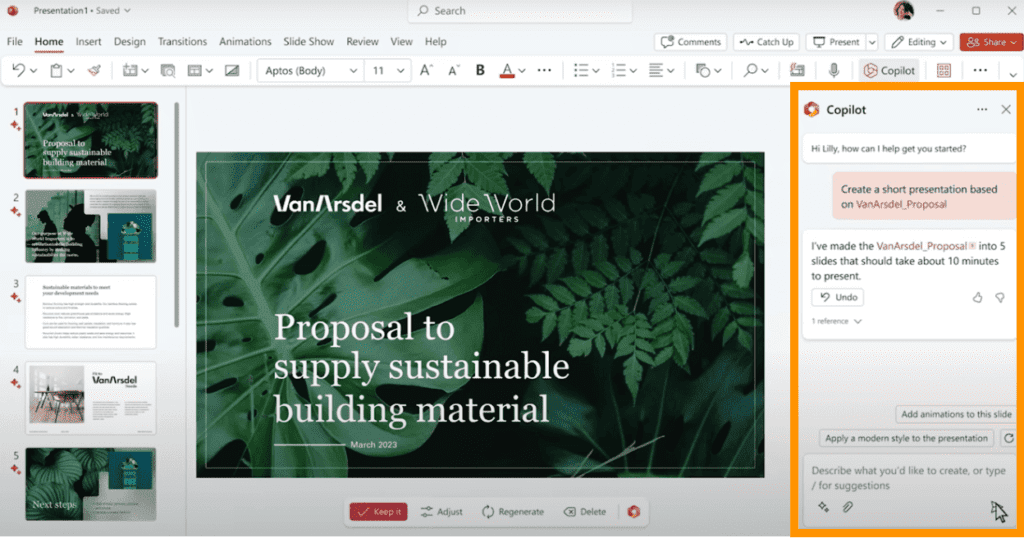
Then, drawing on some advancements in the existing “Design Ideas” feature, you can simply tell Copilot to add animations, additional slides (i.e. “Add a slide about cost/benefits”) and even speaker notes.
For those of us who are using 1% of the features of Excel, there are some solid Copilot capabilities that can help. Using common language, you can ask Copilot to create graphs that help visualize trends, apply colors to the tables to highlight certain data, and model future projections.
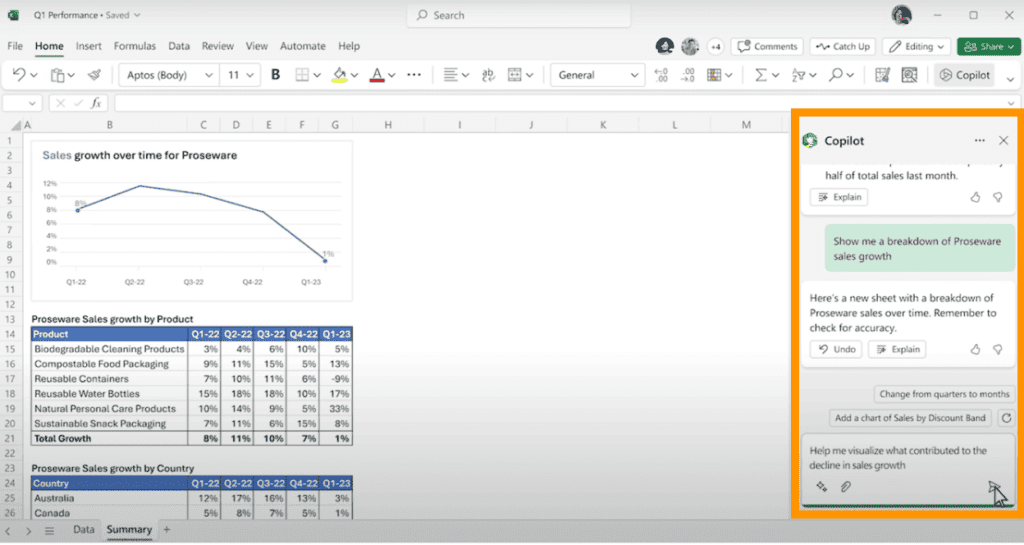
Since important decisions may be made from this data, the output should be well understood. You can ask Copilot for an explanation of how it derived some of its inferences, and it will provide a breakdown.

There are several Outlook / email enhancements too, like highlighting and summarizing the most important emails, and allowing you to draft emails with connected data from OneDrive and Excel, etc. You can even change the tone of the email language.

Power Apps Copilot is previewing, purporting to enable some natural language control to “build an app, including the data behind it, just by describing what you need through multiple steps of conversation.” Based on past experience, this will take much more time to mature.
Finally, Copilot in Teams can help in real-time, as shown below. In this case, a participant arrives late to the meeting. The transcript is humming along in real-time, allowing the participant to recap key points so far, and then dive deeper into the points that they’ve missed. You can ask Copilot what a good question to ask would be (and of whom), check for sentiment of comments, and list action items.

Overall, you’ll start to see helpful tools that you can use natural language to control throughout the M365 experience. The connected fabric of files, notes, and messaging services within Microsoft 365, combined with the ChatGPT learning model, makes it extremely powerful.
How Does It Work?
The Copilot System is made of three components:
Users initiate the process while within the M365 App they’re using, as shown on the top left. The Copilot Systems pre-processes that request and then relays it to the Graph to “ground” it.
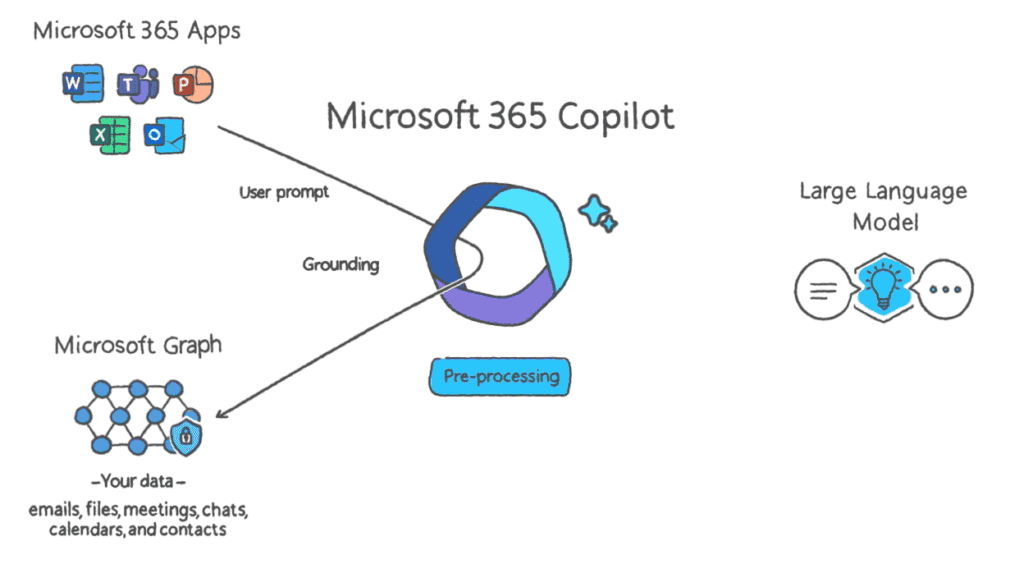
“Grounding” is an important step to produce relevant output. Grounding happens automatically and improves the quality of the prompt before it’s sent to the LLM. That allows the LLM to provide answers that are more relevant and actionable.

Now, the LLM can now draw on real-time sources of relevant data and provide better output as a result. Think of ChatGPT drawing data not just from its own data sources, but from your OneDrive, or your company’s data. Contextual, relevant content will expedite the completion of your tasks.
Copilot takes the response from the LLM and “post-processes” it, where it does additional grounding in conjunction with the graph. It’s here where security, compliance, privacy, and “responsible AI” reviews will be conducted. Here’s where you can expect to employ individual organizational controls (i.e. see below about Data Loss Prevention).
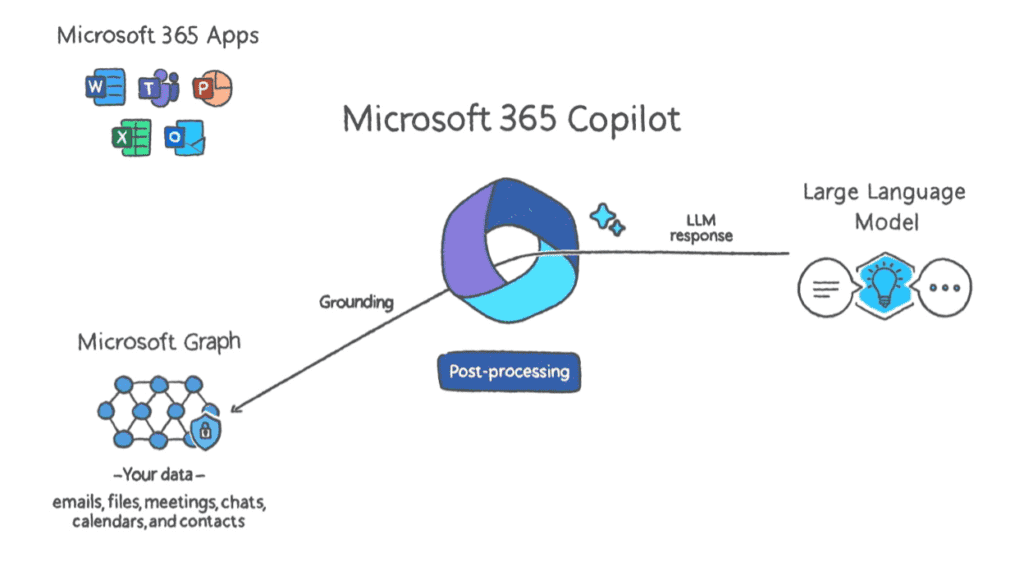
Finally, Copilot sends the response to the user and commands back to the apps (i.e. pulling in data from a Word doc from the graph and creates a new PowerPoint based on that doc).
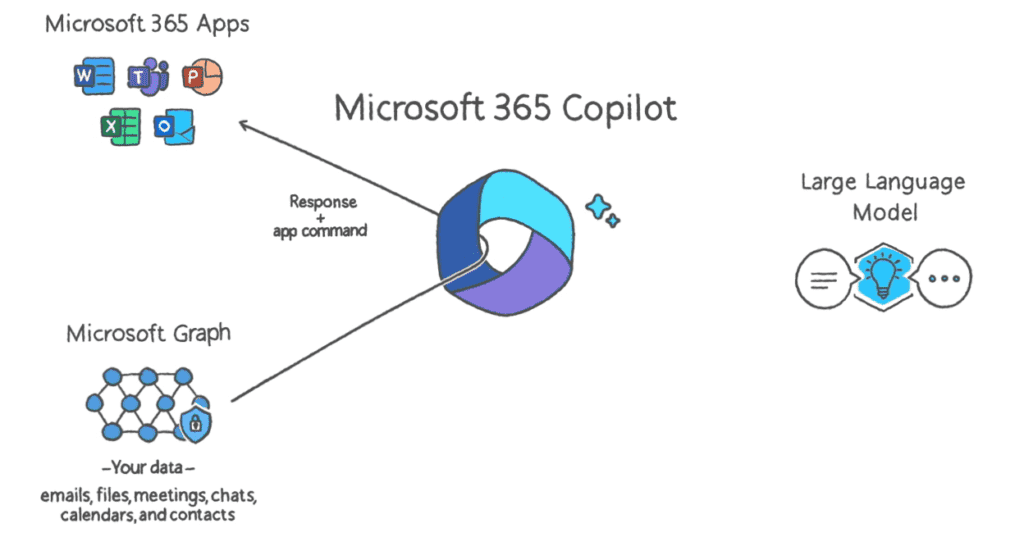
Preparing for AI Within Microsoft 365
While it appears these capabilities are coming out of nowhere, the tooling won’t appear in your tenant without your knowing it. Admins (and licensing) can stand in the way of the tools showing up for users. Here are some important steps to take in advance. For instance, the Power Apps Copilot can be disabled.
Workers will be skeptical and scared – and legitimately so. It’s been said “At work, you will be telling a machine what to do, or a machine will be telling you what to do” (Alec Ross, The Raging 2000s). Help them understand that these tools can be a competitive advantage, if used wisely. They’re used to enhance or speed up, and not replace creativity.
People need to know that AI models can be wrong and should be countered with human reasoning. This should be our behavior for many years, and for many, forever.
Note the use of the word “Draft” several times above. It should be expected that the information drawn from the Graph may be off-base (see the “Keep It” and “Regenerate” options below the PowerPoint slide in a previous image shared above). In its launch, Microsoft’s CVP Jared Spataro said AI “can be usefully wrong.”
The data in your tenant stays within your tenant and isn’t sent or shared with the LLM for training, for others to use or see. Early FAQs like that are answered here: Administration of Microsoft 365 in the new era of AI .
However, it will become more crucial to protect confidential and proprietary information within your Microsoft 365 ecosystem from unexpected (internal exposure). In the future, without the employee needing to even look around for data they need, Copilot may just search SharePoint and offer to import or use key data. This may end up overexposing confidential data. Ensure your privileges are managed well and your data is protected using Microsoft Purview. This is not a trivial investment of time and effort, so take steps to define, inventory, and protect confidential data now, before the AI crawlers become even easier to expose this data.
Summary
The velocity at which Microsoft is embedding AI and LLM into products and services is a testament to how useful the technology is, and also how quickly it is being improved. Seeing a few NDA demos, it’s not vaporware. The sky’s the limit with how this can help an organization, and it’ll happen soon.
One can debate how well Microsoft’s Responsible AI principles will counter the competitive benefits this technology may provide them. However, one shouldn’t debate the importance of protecting confidential information, and educating users. The workforce needs to be prepared to effectively use the technology for competitive advantage, helping them understand how to move their career forward, rather than be threatened, in the presence of such game-changing tools.
Contact our team of experts with any questions you may have about these changes coming to Microsoft 365 by emailing info@eGroup-us.com.

CTO & VP of Strategy - eGroup | Enabling Technologies
Learn how to leverage AI within your current Microsoft solutions!
Contact our team of experts to inquire about any questions you have about these new features coming to Microsoft 365.
Last updated on July 31st, 2023 at 12:31 pm